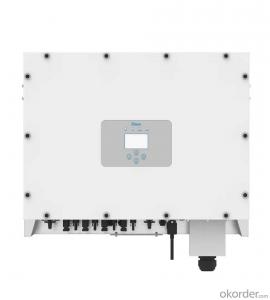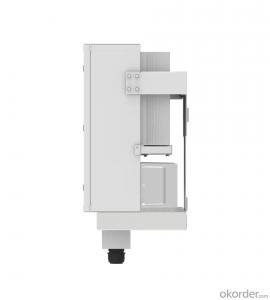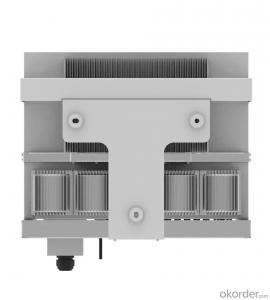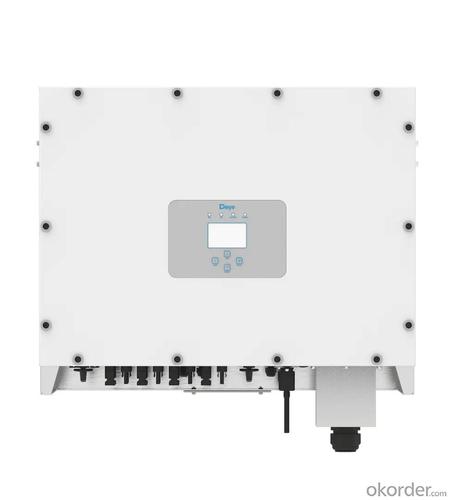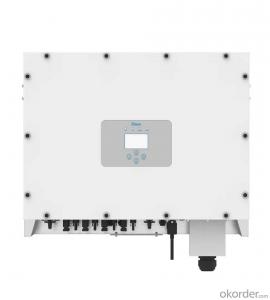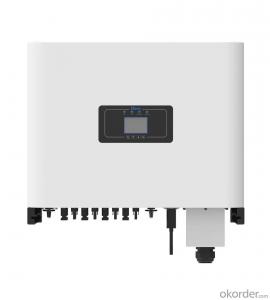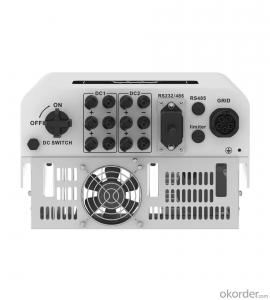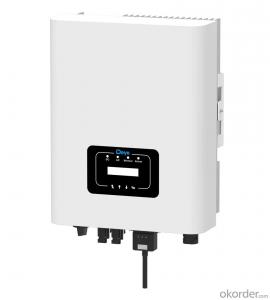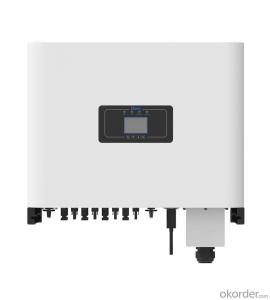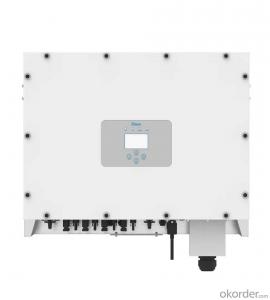Large Solar Inverter - Sun-35/40/45/50k-g-lv | 35-50kW | Three Phase | 4 MPPT | Low Voltage 127/220VAC
- Loading Port:
- Ningbo
- Payment Terms:
- TT OR LC
- Min Order Qty:
- 100 pc
- Supply Capability:
- 5000 pc/month
OKorder Service Pledge
OKorder Financial Service
You Might Also Like
Specification
| Technical Data | ||||||
| Model | SUN-35K-G02-LV | SUN-40K-G-LV | SUN-45K-G-LV | SUN-50K-G-LV | ||
| Input Side | ||||||
| Max. DC Input Power (kW) | 45.5 | 52 | 58.5 | 65 | ||
| Max. DC Input Voltage (V) | 800 | |||||
| Start-up DC Input Voltage (V) | 250 | |||||
| MPPT Operating Range (V) | 200~700 | |||||
| Max. DC Input Current (A) | 30+30+30+30 | 40+40+40+40 | ||||
| Max. Short Circuit Current (A) | 45+45+45+45 | 60+60+60+60 | ||||
| Number of MPPT / Strings per MPPT | 4/3 | 4/4 | ||||
| Output Side | ||||||
| Rated Output Power (kW) | 35 | 40 | 345 | 50 | ||
| Max. Active Power (kW) | 38.5 | 44 | 49.5 | 55 | ||
| Nominal Output Voltage / Range (V) | 3L/N/PE 127/0.85Un-1.1Un,220 /0.85Un-1.1Un (this may vary with grid standards) | |||||
| Rated Grid Frequency (Hz) | 60 / 50 (Optional) | |||||
| Operating Phase | Three phase | |||||
| Rated AC Grid Output Current (A) | 91.9 | 104.9 | 118.1 | 131.2 | ||
| Max. AC Output Current (A) | 101.1 | 115.5 | 129.9 | 144.4 | ||
| Output Power Factor | 0.8 leading to 0.8 lagging | |||||
| Grid Current THD | <3% | |||||
| DC Injection Current (mA) | <0.5% | |||||
| Grid Frequency Range | 57~62 | |||||
| Efficiency | ||||||
| Max. Efficiency | 98.7% | |||||
| Euro Efficiency | 98.3% | |||||
| MPPT Efficiency | >99% | |||||
| Protection | ||||||
| DC Reverse-Polarity Protection | Yes | |||||
| AC Short Circuit Protection | Yes | |||||
| AC Output Overcurrent Protection | Yes | |||||
| Output Overvoltage Protection | Yes | |||||
| Insulation Resistance Protection | Yes | |||||
| Ground Fault Monitoring | Yes | |||||
| Anti-islanding Protection | Yes | |||||
| Temperature Protection | Yes | |||||
| Integrated DC Switch | Yes | |||||
| Remote software upload | Yes | |||||
| Remote change of operating parameters | Yes | |||||
| Surge protection | DC Type II / AC Type II | |||||
| General Data | ||||||
| Size (mm) | 700W×575H×297D | |||||
| Weight (kg) | 60 | |||||
| Topology | Transformerless | |||||
| Internal Consumption | <1W (Night) | |||||
| Running Temperature | -25~65℃, >45℃ derating | |||||
| Ingress Protection | IP65 | |||||
| Noise Emission (Typical) | <55 dB | |||||
| Cooling Concept | Smart cooling | |||||
| Max. Operating Altitude Without Derating | 2000m | |||||
| Warranty | 5 years | |||||
| Grid Connection Standard | CEI 0-21, VDE-AR-N 4105, NRS 097, IEC 62116, IEC 61727, G99, G98, VDE 0126-1-1, RD 1699, C10-11 | |||||
| Operating Surroundings Humidity | 0-100% | |||||
| Safety EMC / Standard | IEC/EN 61000-6-1/2/3/4, IEC/EN 62109-1, IEC/EN 62109-2 | |||||
| Features | ||||||
| DC Connection | MC-4 mateable | |||||
| AC Connection | IP65 rated plug | |||||
| Display | LCD 240 × 160 | |||||
| Interface | RS485/RS232/Wifi/LAN | |||||
This series inverter is specially designed for 127/220Vac three-phase system, providing rated power at 35KW, 40KW, 45KW, 50KW. Equipped with large LCD and buttons, easy to operate and maintenance. With compact design and high-power density, this series supports 1.3 DC/AC ratio, saving device investment.
127/220Vac and 60Hz, three phase system
4 MPP tracker, Max. efficiency up to 98.7%
Zero export application, VSG application
String intelligent monitoring (optional)
Wide output voltage range
Type II DC/AC SPD
Anti-PID function (Optional)
- Q: Can a solar inverter be used with a solar-powered irrigation system?
- Yes, a solar inverter can be used with a solar-powered irrigation system. A solar inverter is responsible for converting the direct current (DC) produced by the solar panels into alternating current (AC), which is required to power various electrical devices. In the case of a solar-powered irrigation system, the solar inverter can convert the DC generated by the solar panels into AC to power the irrigation pump or other electrical components of the system. This ensures that the solar energy captured by the panels can be effectively utilized for irrigation purposes.
- Q: Can a solar inverter be used with a solar-powered greenhouse system?
- Yes, a solar inverter can be used with a solar-powered greenhouse system. A solar inverter converts the direct current (DC) generated by solar panels into alternating current (AC) that can be used to power electrical devices in the greenhouse system. This allows for efficient utilization of solar energy for various applications such as lighting, ventilation, irrigation, and temperature control within the greenhouse.
- Q: What are the key factors affecting the warranty coverage of a solar inverter?
- The key factors affecting the warranty coverage of a solar inverter include the length of the warranty period, the terms and conditions outlined in the warranty document, the reputation and financial stability of the manufacturer, the quality and reliability of the inverter components, and any limitations or exclusions stated in the warranty.
- Q: How does a solar inverter handle voltage and frequency variations caused by load shedding?
- A solar inverter is designed to handle voltage and frequency variations caused by load shedding by having built-in mechanisms and control systems. When load shedding occurs and the grid voltage or frequency deviates from the normal range, the solar inverter detects these variations and adjusts its operation accordingly. To handle voltage variations, the solar inverter employs a voltage regulation system. It continuously monitors the grid voltage and compares it with the standard voltage level. If the grid voltage decreases or increases beyond the acceptable range, the inverter adjusts its internal voltage conversion process to maintain a stable output voltage. This ensures that the connected solar panels continue to generate power within the acceptable voltage limits, minimizing any negative effects due to voltage fluctuations. Similarly, for frequency variations caused by load shedding, the solar inverter has a frequency regulation mechanism. It monitors the grid frequency and compares it with the standard frequency level. In cases of frequency deviations, the inverter adjusts its internal synchronization process to match the grid frequency. This allows the inverter to synchronize with the grid and feed the generated solar power in a manner that is compatible with the grid's frequency. In addition to voltage and frequency regulation, solar inverters often have additional functionalities to enhance their ability to handle variations caused by load shedding. These may include features such as anti-islanding protection, which ensures that the solar system disconnects from the grid during a power outage to prevent safety hazards to utility workers attempting to restore power. Furthermore, some advanced inverters can also have energy storage capabilities, allowing them to store excess solar energy and provide uninterrupted power supply during load shedding events. Overall, solar inverters are specifically designed to handle voltage and frequency variations caused by load shedding. Through their regulation and control systems, they ensure that the solar power generated from the panels remains stable and compatible with the grid, providing a reliable and efficient power supply even during challenging grid conditions.
- Q: How does a solar inverter handle frequency variations in the grid?
- A solar inverter handles frequency variations in the grid through its built-in control mechanisms. It continuously monitors the frequency of the grid and adjusts its own output accordingly to match the grid frequency. This ensures that the solar inverter remains synchronized with the grid and allows for seamless power transfer between the two.
- Q: What is the role of a grid monitoring feature in a solar inverter?
- The role of a grid monitoring feature in a solar inverter is to constantly monitor the electrical grid for voltage, frequency, and other parameters. This feature ensures that the solar inverter is synchronized with the grid and operates within the specified limits. It helps in maintaining a stable and reliable connection between the solar system and the grid, preventing any damage to the inverter or the grid. Additionally, grid monitoring also enables the solar inverter to detect any faults or abnormalities in the grid and take appropriate measures to protect the system and ensure safe operation.
- Q: What are the key safety features to look for in a solar inverter?
- Some key safety features to look for in a solar inverter include: 1. Overvoltage and overcurrent protection: The inverter should have mechanisms in place to prevent excessive voltage or current levels, ensuring the safety of the system and connected devices. 2. Ground fault protection: This feature detects and protects against faults in the grounding system, reducing the risk of electric shock or damage to the inverter. 3. Temperature monitoring and control: The inverter should have built-in temperature sensors to monitor and regulate its internal temperature. This helps prevent overheating and potential fire hazards. 4. Arc fault detection: Arc faults can occur in electrical systems and pose significant safety risks. An inverter with arc fault detection can identify and mitigate these faults, minimizing the chance of electrical fires. 5. Rapid shutdown capability: In the case of an emergency or maintenance, the inverter should have the ability to rapidly shut down the solar system. This feature helps ensure the safety of installers, firefighters, or anyone working on the system. 6. Compliance with safety standards: Look for inverters that meet relevant safety standards, such as UL 1741, IEC 62109, or other local regulations. These standards ensure that the inverter has undergone rigorous testing and meets specific safety requirements. Overall, a solar inverter with these key safety features can help enhance the safety and reliability of a solar power system.
- Q: What is the function of a solar inverter in a solar power system?
- The function of a solar inverter in a solar power system is to convert the direct current (DC) produced by the solar panels into alternating current (AC), which is the type of electricity used in most homes and businesses. This allows the solar energy to be utilized for powering electrical appliances, feeding excess energy back into the grid, or storing it in batteries for later use.
- Q: How do you size a solar inverter for a solar power system?
- To size a solar inverter for a solar power system, you need to consider the maximum power output of your solar panels. This can be determined by looking at the wattage rating of each panel and multiplying it by the number of panels in your system. Once you have the total power output, you should choose an inverter with a capacity slightly higher than the calculated value to allow for any future expansions or increases in power generation. Additionally, it is important to consider the type of inverter, such as string, micro, or hybrid, based on the specific requirements and constraints of your solar power system.
- Q: What is the role of a solar inverter in a solar-powered electric fence?
- The role of a solar inverter in a solar-powered electric fence is to convert the direct current (DC) generated by the solar panels into alternating current (AC) that is used to power the electric fence system. The inverter ensures that the energy captured by the solar panels is transformed into a usable form for the electric fence, allowing it to function efficiently.
Send your message to us
Large Solar Inverter - Sun-35/40/45/50k-g-lv | 35-50kW | Three Phase | 4 MPPT | Low Voltage 127/220VAC
- Loading Port:
- Ningbo
- Payment Terms:
- TT OR LC
- Min Order Qty:
- 100 pc
- Supply Capability:
- 5000 pc/month
OKorder Service Pledge
OKorder Financial Service
Similar products
Hot products
Hot Searches
Related keywords
